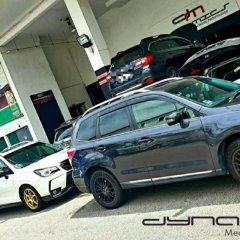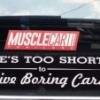Search the Community
Showing results for 'Every'.
-
Great video! Reminds me of the time my father held several jobs to support the family. Allows me to appreciate my girl's love letters to me. https://video-sin1-1.xx.fbcdn.net/hvideo-xfp1/v/t43.1792-2/10942380_783949568319418_1074050982_n.mp4?efg=eyJybHIiOjE1MDAsInJsYSI6MjgxNSwidmVuY29kZV90YWciOiJsZWdhY3lfaGQifQ%3D%3D&rl=1500&vabr=726&oh=6ecee8fe222a66f5675794137dc3743a&oe=55E3E392
- 87 replies
-
- 10
-

-
- inspiring
- inspiring video
-
(and 6 more)
Tagged with:
-
According to Reuters, Tesla had to cut its production targets for the 2015 year down to 50,000-55,000 vehicles after releasing how much it is losing. It is said that Tesla is losing $4000 (S$5571) on every Model S they sell after taking into consideration the operating losses of the company which amounted to $47million (S$65.5million). Shares of the electric car company fell almost 9 percent last Thursday with another 2 percent slip on Friday. Analysts predict that a capital raise is probably on its way as Tesla’s reserves were standing at just $1.15billion (S$1.60billion) on 30th of June , down from $2.67billion (S$3.72billion) a year ago, a reduction that's partly due to investments for the production start of the new Model X electric crossover.
-
Do you guys wax after every wash to protect the coat of paint?
-

Nissan's Legendary Takumi: The master craftsmen who hand-build every GT-R engine
Deeq posted a blog entry in MyAutoBlog
In Japan, the term takumi is used to describe a master craftsman who has perfected his skills over years of painstaking work and dedication. It is reserved for those who are at the very top of their profession. At Nissan's expansive engine factory in Yokohama, four men have been designated as takumi. They are the sole assemblers of the engines that power one of the most heralded sports cars in automotive history. https://www.youtube.com/watch?v=KMqRuN7wyvQ The four takumi of Nissan's Yokohama plant are Takumi Kurosawa, Tsunemi Ooyama, Izumi Shioya and Nobumitsu Gozu. Collectively, they share over 100 years of exceptional work in their chosen field. These engine craftsmen are responsible for hand-building every awe-inspiring 545-horsepower twin-turbocharged V-6 engines found beneath the hood of the Nissan GT-R, production vehicles and the racecars alike. Each engine is assembled with care and precision by one of these four individuals. Once an engine is completed, the takumi craftsman proudly mounts a plaque bearing his name upon the completed masterpiece, serving as a timeless reminder of the high level of craftsmanship and expertise that went into each work. Many Nissan GT-R owners have visited the Yokohama plant and to meet the takumi engine-builder who hand-assembled their Nissan GT-R's engine. Even popular American late-night television talk show host and car collector/aficionado Jay Leno has made the trip to the plant to meet the takumi. Nissan's Yokohama plant is a model of both technology and efficiency within the industry. In its nearly eight decades in existence, it has produced more than 35 million engines, including the exceptionally-capable VR38 that powers the legendary Nissan GT-R high-performance sports car. "Yokohama is the plant where our company was established, and we're proud to make Nissan's flagship engine here. It represents the pinnacle of the Nissan brand," said Nobuhiro Ozawa, Yokohama plant manager. "We adhere the nameplates of the takumi who hand-built these engines and put their souls into each one with a sense of responsibility." -
Hey hey hey ......... Sg make it again .......... top 10 ! World Ranking Who say Japan is expensive .......... haha
- 5 replies
-
- 3
-

-
.png)
-
- world
- cost of living
-
(and 5 more)
Tagged with:
-
Periods are the worst time of the month for females. We feel like we’re dying, we hate everyone and everything, work isn’t optional and all we want to do is crawl into our beds and never come out. Our guy friends, boyfriends and dads can’t feel our pain, but all of the women in our lives can relate. We love to bitch about our periods, regardless of the fact that we’ve been dealing with them every month since we were 13(ish). It doesn’t matter; girls love to complain and love to have people who will listen. Bitching about your period basically ensures a great audience. We have a love/hate relationships with our periods because it’s an excuse to eat whatever we want and to be a huge bitch, to sum it all up. No? Just me? No way. More of that later. What are the most common phrases women say to one another during this terrible time? Check it out below. 1. “Am I dying?” Seriously, it is not normal to bleed this much and not die. 2. “I’m so bloated.” UGH! Why am I so fat today? This is the worst feeling ever. Looks like I’ll be sticking to leggings for the next three to five days. 3. “At least I’m not pregnant!” This is probably the ONLY upside to getting your period, literally. 4. “Sorry I’m being a total bitch right now, but I’m on my period.” Get-out-of-jail-free card? Thank you very much, uterus. 5. “Can you really not get pregnant while having sex on your period?” Is this true? Is this a myth? Or is it just wishful thinking? FYI: Yes, you can totally get pregnant while on your period. 6. “Anyone have a tampon?” Somebody needs to wingardium leviosa a tampon to me right now because there is nothing worse than sitting at work realizing you forgot to bring backup. 7. “It’s my last day, will he know?” At that point, no one gives a sh*t. Both parties involved will be too busy to even figure out what’s going on, anyway. Well, hopefully for your sake. 8. “Do people still use pads?” #TBT: Pads! Hahaha, these are literally adult diapers. Can you actually believe people used these things willingly? Sh*t is disgusting. 9. “Seriously?! Another comforter bites the dust?” Every girl has had to experience something along these lines. There’s nothing worse than drifting off to sleep only to realize the crimson monster has made its way through your sheets. 10. “Is TSS real?” I’ve had this in for like seven hours. Is that too long? 11. “I don’t even want kids!!” I’m well aware of the fact I will never have kids. Can I just remove my uterus, already? 12. “I can eat whatever I want. I deserve it.” The best part (like there is one) of being on our periods is that fact that we can rationalize any and every morsel of food that passes through our lips. 13. “I need chocolate!” This is self-explanatory. 14. “I don’t have to go to the gym, right?” Who the hell wants to do jumping jacks on their period? Not me, that’s for sure. 15. “This underwear cost me $26!” You have your date-night underwear, your daytime underwear and then the reject pile that’s reserved for your period week. We may have been dealing with this sh*t for years, but for some reason, we never learn our lesson. 16. “Midol is a lie.” The 15 minutes of relief (if that) that this medication provides is totally not worth the money. You’re much better off smoking a joint, trust me. 17. “I’m allowed to be a bitch.” I can be a huge bitch and no one can say a damn thing because it’s my hormones speaking! #Winning 18. “I hate everyone.” All women are more irritable on their periods, and with good reason. This time of the month is painful and uncomfortable, putting us on edge for every conversation we’re going to engage in. 19. “Why does the government not pay for tampons?” Clinics give away condoms but not tampons? How does this make any sense? Insurance should totally pay for tampons. A whole box is like $16. Ain’t nobody got money for that. 20. “I just want to curl up in a ball and die.” I. Need. My. Bed. Right. Now. 21. “Why do I have to go into work today?” Women should totally get a day off during that time of the month. I mean you all have that one day that is significantly worse than the rest. Cue the heating pad. 22. “Ugh, I should’ve just skipped it this month.” For the lucky girls who are on birth control, they have the option to skip their period, altogether, each month. But for the rest of us, unfortunately, this is just not an option. 23. I WISH I WAS A GUY! If you have not uttered these words, you haven’t really experienced a period. Men don’t know how good they have it. Source: http://elitedaily.com/women/23-things-that-every-girl-has-said-while-on-her-period/
-
Incidents of road rage are on the rise in Singapore, with known attacks occurring once every four days last year. Reported cases that resulted in assault rose to 97 last year, up from 84 in 2011 and 63 in 2010. Some of the cases were heard in court in recent months. A businessman was sentenced to one month in jail earlier this month for punching a technician he felt should have given way to him on a street in Jurong East. Source: http://www.straitstimes.com/breaking-news/...gapore-20130526
-
AS MANY as 110 errant drivers were caught running the red light in school zones in the first six months of this year alone. That translates to an average of nearly five cases a week. Drivers were also caught for other offences in school zones, such as speeding and tailgating. The Traffic Police gave these updates in response to queries from The Straits Times. Since January, road safety in school zones has been beefed up with harsher punishments, after two brothers were killed by a truck in Tampines last year. Nigel Yap, 13, was cycling across the road with Donavan, seven, who was riding pillion, when the driver hit them. The police did not have a breakdown of the number of offences committed within school zones before the law was toughened earlier this year. Those who run a red light in a school zone will get 13 demerit points - one more than before. For drivers with less than a year's experience, it means their licences will be revoked as they have exceeded the maximum of 12 demerit points in one year. Speeding was the second most common offence in these demarcated areas. Within the first six months of this year, 23 summonses were issued against speedsters who exceeded the 50kmh limit. The Land Transport Authority lowered speed limits outside 10 primary schools to 40kmh in January as part of a pilot project which will be rolled out to more schools progressively. In the first six months of this year, there were also eight cases of inconsiderate driving and 17 instances of careless driving. Examples include tailgating and sudden lane switches. There are more than 300 school zones at primary and secondary schools. MP for Tampines GRC Baey Yam Keng said drivers should keep a lookout at all times in school zones, not just at dismissal hours. "There are schoolchildren who are coming and going all the time. Some of them stay back for CCA (co-curricular activities), some are waiting for their parents. It's alarming and worrisome the number is so high." Nurse May Tan, 52, mother of three, said: "I always remind my kids not to take for granted that green light means 'go', and to watch out for speeding cars. I tell them, 'This involves your life'." Source: http://www.straitstimes.com/news/singapore/transport/story/school-zone-yet-5-drivers-run-red-light-every-week-20140811?page=1
- 14 replies
-
- 6
-

-
- school zone
- school
- (and 5 more)
-
Like they say, to become great, you need to have a good start. Cue a video of all the best cars in the world starting up. From the '69 Jaguar E-Type's quiet Inline-6 to the the rumble of the Aventador's 6.5L V12, every single car is recorded and strung up into a 4-minute video for us to savour. So let's just sit back and enjoy the symphony of all 33 unique cars singing one after another. http://dai.ly/x1sq8ef_getting-started-every-epic-story-has-a-great-start_auto
-

Ferrari to launch new model every year, keep production limited
Deeq posted a blog entry in MyAutoBlog
You've no doubt perused the big news coming out of Fiat-Chrysler's headquarters in Auburn Hills, MI today. But at the end of the brand discussions, Sergio Marchionne spoke briefly about an incredibly important, low-volume part of the Fiat-Chrysler empire: Ferrari. "You do need one of these cars in your driveway," Marchionne joked. And while other brand heads today lined out detailed plans for future product, Sergio's words about Ferrari's next five years were very simple, and very vague. Marchionne confirmed that Ferrari will launch a new car every year between now and 2018. The cars will have a four-year lifecycle, after which, "M" versions will be produced, with a separate four-year cadence. No specific models were mentioned during Marchionne's presentation. The Fiat-Chrysler boss confirmed that Ferrari will not break its cap of limiting production to just 7,000 units per year. This is a "willful and intended" limitation by Ferrari, Marchionne said, but did note that the Italian automaker could ramp up production to 10,000 cars per year in the future. Finally, Marchionne talked briefly about Ferrari's value as a whole, simply saying that the brand "is not for sale." Ferrari is a "phenomenal repository of value" for Fiat. Ninety percent of Ferrari's stock sits within Fiat and its shareholders, and as Marchionne says, "That's where it belongs." -
One of the first choices a driver is faced with, whether the car is brand-new or high-mileage, is between mineral and synthetic engine oil. In a nutshell, mineral oil is the stuff that comes from the ground and is created as part of the oil refining process. This type of oil has been around as long as cars have been around, and it's less expensive than synthetic oils. Synthetic oils are more expensive because of the chemical engineering involved in creating them. They still have a base mineral oil, but they've been engineered to allow for more miles to be driven between oil changes, and they often have additives to help keep the oil cleaner, longer. It's also more stable at higher and lower temperatures than mineral oil. Speaking of temperatures, let's take a look at what those numbers on the bottle mean. It's intimidating when you see those bottles of engine oil lined up along the shelves, each promising to keep your engine cleaner, improve your fuel efficiency and more. And every one of them has cryptic letters and numbers on the front. Those letters and numbers tell you what the oil's viscosity rating is (some people call this the oil's weight). Viscosity is a measure of how easily the oil flows -- is it thick or thin? The Society for Automobile Engineers (SAE) tests all engine oil at 210 degrees Fahrenheit (98.9 degrees Celsius), a typical engine operating temperature, and gives it a rating from 20 to 60. On the bottle, it will say something like SAE 20 or SAE 30, two common viscosities. If you live in a colder climate, the label will be a little different. It will likely say something like 5W-30. The "5W" means that the SAE has tested the viscosity of the oil at a colder temperature. This oil will be thinner when you start the engine on a cold morning but will perform like an SAE 30 oil at 210 degrees Fahrenheit (98.9 degrees Celsius), when you've been driving a few minutes and the engine is warm. In any case, your owner's manual will likely have a suggested oil rating for your car. A trusted mechanic will be able to help you choose, too. Just remember that colder starts need a thinner oil at first, and warm engines need a thick enough oil to not disappear when the engine becomes warm. Next up: The oil change. For decades, there was one basic rule for changing the oil in your car: every 3,000 miles (4,828 kilometers) or 3 months, whichever came first. Easy, right? However, with the advances in engine performance and design, plus the advances in engine oil technology, most cars can go farther between oil changes. But how far? Many modern cars can go 5,000 or even 10,000 miles (8,047 or 16,093 kilometers) between oil changes, depending on the model and how you drive. Most people won't go wrong with a 5,000-mile (8,047-kilometer) interval between changes, but if your daily commute involves lots of stop-and-go driving, you might want to change it a little sooner. Some cars can even keep track of the oil and alert the driver when it's time for a change. Chris Martin of Honda says his company's Maintenance Minder, for instance, "monitors engine operating conditions and accumulated engine revolutions to recommend specific maintenance, like oil changes, when it's actually required, rather than relying on a set maintenance schedule." This keeps the engine in its best shape and saves the owner money on maintenance. Next, the easiest of all maintenance: Checking your oil. This is one car maintenance practice that hasn't changed much over the years. Just about anyone can do it, and it has the added benefit of getting you to lift your hood and actually see what your engine looks like. Most of the engine will be encased in some kind of cover with a lot of wires and hoses coiled around it. But somewhere in there, usually toward the front, you'll find the dipstick. It likely has a loop or hook on the end for pulling it out. When the engine is cool, pull out the dipstick and wipe off whatever you find on the end with a towel. Notice the markings at the end of the stick -- the minimum and maximum levels are marked, sometimes with crosshatching between them or even holes in the metal. Put the dipstick back into the engine and pull it out again. Now check to see where the oil level is. It should be closer to the maximum than the minimum, but not over full. It's okay if the oil is brown or black; that just means it's doing its job. Replace the dipstick, wash your hands, and feel good that there's still something in the engine compartment that you can take care of. Wait -- was the level low? Well there's more you can do, then. Keep reading to find out how to safely add oil to your engine.Most of the engine will be encased in some kind of cover with a lot of wires and hoses coiled around it. But somewhere in there, usually toward the front, you'll find the dipstick. It likely has a loop or hook on the end for pulling it out. You've checked the oil, and it was a bit low. No big deal -- just add a bit more. Quarts of oil are pretty cheap; if you're comfortable with the viscosity rating recommendation for your car, you can pick up oil almost anywhere, including big box stores and even some grocery stores. If you'd like a little hand-holding, the local auto parts store would be able to help. With a cool engine, use the dipstick to check your oil to see exactly how low it is. Locate the oil cap on top of the engine and unscrew it. Using a funnel, add about half of the bottle of oil, wait a minute or two, then check the dipstick again. You don't want to overfill the engine. When the oil level is just below maximum, screw the oil cap back on and make sure the dipstick is back in place. The funnel should have kept the whole process fairly neat and tidy, but if any oil spilled onto the outside of the engine, it's not the end of the world. However, you'll likely smell it burning off the next time you drive. When the engine is cool, pull out the dipstick and wipe off whatever you find on the end with a towel. Notice the markings at the end of the stick -- the minimum and maximum levels are marked, sometimes with crosshatching between them or even holes in the metal. Put the dipstick back into the engine and pull it out again. Now check to see where the oil level is. It should be closer to the maximum than the minimum, but not over full. It's okay if the oil is brown or black; that just means it's doing its job. Replace the dipstick, wash your hands, and feel good that there's still something in the engine compartment that you can take care of. Wait -- was the level low? Well there's more you can do, then. Keep reading to find out how to safely add oil to your engine. You've checked the oil, and it was a bit low. No big deal -- just add a bit more. Quarts of oil are pretty cheap; if you're comfortable with the viscosity rating recommendation for your car, you can pick up oil almost anywhere, including big box stores and even some grocery stores. If you'd like a little hand-holding, the local auto parts store would be able to help. With a cool engine, use the dipstick to check your oil to see exactly how low it is. Locate the oil cap on top of the engine and unscrew it. Using a funnel, add about half of the bottle of oil, wait a minute or two, then check the dipstick again. You don't want to overfill the engine. When the oil level is just below maximum, screw the oil cap back on and make sure the dipstick is back in place. The funnel should have kept the whole process fairly neat and tidy, but if any oil spilled onto the outside of the engine, it's not the end of the world. However, you'll likely smell it burning off the next time you drive.
-
He has everything you ever dreamed of! Definitely not husband material though................... - Cars (Many many cars!) - $$$ (LOTS OF IT, he is a professional poker player. Made millions of dollars playing cards and gambling) - Houses (and they come with breathtaking views) - WOMEN (scantily-clad women, they're all on his instagram. Amazing how liberal they can be.) For those who has instagram, check out his username @ danbilzerian. Parental guidance needed hor! For those without, http://web.stagram.com/n/danbilzerian/?vm=grid Info about him: http://www.buzzfeed.com/mrloganrhoades/this-millionaire-playboy-is-the-most-interesting-man-on-inst Full of these women on his instagram.
- 28 replies
-
- danbilzerian
- dan bilzerian
-
(and 5 more)
Tagged with:
-
A goal every 40 seconds...... Super duper KELONG ..... yahoo reported: Nigerian Football Federation suspends teams involved in 'scandalous' 79-0 and 67-0 victories The Cameroonian Football Association are facing some problems right now
-
Partly in Gedong, partly in Germany. Ex-armour people will probably relate to this quite well, except the fact that the tanks are much bigger than the SM-1 we used to have That being said, the bunch of cadets sound very "air level" JC-types...... quite well spoken, but talk a lot of bird also...... one keeps harping on the 60 ton tank statistic......
- 18 replies
-
- Every
- Singaporean
-
(and 3 more)
Tagged with:
-
Won't sell up? Enjoy living in the middle of a motorway! Road is built around a house after elderly Chinese couple refuse to move A lone apartment building stands in the middle of a newly built road after an elderly couple refused to relocate. Luo Baogen and his wife insist on living in the half-demolished building in the city of Wenling, in Zhejiang province, China because they believe that the relocation compensation offered by the government is not enough. Now the only building left standing, the five storey block is a strange sight as cars drive around it while the couple remain living inside. To ensure the couple
-
$808,080 HDB sale hits the roof By Benson Ang Just how much are people willing to pay for an HDB flat? Mr Freddy Choo paid $808,080 for his executive maisonette in Tampines. Worth every cent, he said. The price includes a whopping $168,080 in cash over valuation (COV). That's among the largest COVs paid since the financial crisis in 2008, said real estate agents. One of the previous reported highs was about $200,000 for an HUDC flat in Shunfu. It was sold at $1.1 million in July, 2010. Mr Choo, 46, said he was willing to pay a premium as his new home was renovated just five years ago and came fully-furnished. The real estate agent had come across the unit, on the eighth storey of Block 146, Tampines Avenue 5, in April. The 150 sq m flat is two bus stops away from the Tampines MRT station and Tampines Mall. Mr Choo said it was valued at $640,000. The median resale price of executive flats in Tampines was $640,000 as of the second quarter of 2012, according to HDB's website. The father of two said the final amount - $808,080 - was also an auspicious number. It is the highest price paid for an executive HDB flat in Tampines in the past year, according to HDB's website which shows transacted prices. Mr Choo is married to another real estate agent, and they have a daughter, nine, and a son, 13. Mr Choo said his family had previously owned a condominium penthouse in Geylang, which he sold for $1.4 million. To pay for his new place, Mr Choo has taken out a 24-year loan of $560,000, saying: "You can always earn more money. "But it's not easy to find a suitable flat which you can call home." "I searched for a month and looked at six units before I decided on this one." The block is about 600m away from St Hilda's Secondary which Mr Choo's son attends. His daughter, Schermaine, attends the nearby St Hilda's Primary School. She said: "I can walk to school in 10 minutes. There's also a park, shopping mall and playground nearby for me." Mr Choo's family was also drawn by the extensive renovation to the unit. He said the previous owner had spent $200,000 and had fittings such as a water feature in the living room, and glass banisters. And Mr Choo claimed the owners left behind furniture worth $100,000.Some of the furniture they included a custom-made bed, Japanese-style tabletop and a Swarovski crystal chandelier worth $3,000. They also left electrical appliances like a flat-screen TV, fridge and speakers. Said Mr Choo: "They were also a Singaporean family who upgraded to a condominium. They initially wanted a COV of $240,000, but I managed to bargain down." The previous owners could not be contacted as Mr Choo said he does not have their telephone number. The transaction was approved in May and Mr Choo's family moved in two weeks ago. He said: "All my friends who have seen my place say it is worth the amount I paid." Good buy? Mr Albert Lu, key executive officer of property firm C&H Properties, told TNP: "On the surface, the figure definitely looks like a lot. "But if what Mr Choo says about the renovation and furnishings is true, it is actually a good buy." Most flat owners, he said, spend under $100,000 on renovations. "For someone to spend $200,000, the renovations would have been very 'high-class'." Mr Mohamed Ismail, chief executive officer of PropNex, agreed. He said: "In this case, the transaction seems value-for-money, considering the value of the renovation and furnishing the previous owner left behind." COVs have exceeded $160,000 before, said Mr Ismail. For example, he encountered two such flats - one in Yishun and another in Jurong East - in 1996. Indeed, it was previously reported that resale prices had hit a high in 1996, with the median COV going as high as $42,000 in the third quarter of 1996. Since the economy recovered after the 2008 financial crisis, it is possible for some COVs to have returned to such "spikes", Mr Ismail added. Mr Chris Koh, director of property firm Chris International, said Mr Choo's case is the largest COV transaction he has come across since 2008. It was previously reported that in 2007, some home-owners were asking for COV sums of more than $150,000 in certain mature estates. "But if the flat was well-renovated and well-furnished, as claimed by Mr Choo, I can understand why he agreed to pay such a large amount of COV." Half of all flats sold are renovated, he estimated, but only about 20 per cent have good furniture for buyers to use, he said. "Most owners tend to bring their furniture along with them when they move out." Only about 5 per cent of all flats can command such high COVs, he added. All three did not think this case was reflective of housing prices in general. Mr Koh said: "This is a resale flat, which is more expensive than a Build-to-Order (BTO) one. "The BTO flats are still affordable, and there are many schemes to help young couples get these flats quickly." For example, a four-room flat in Tampines Alcoves and Tampines Green Terrace - BTO projects launched earlier this year - was reported to cost $292,000. Mr Ismail warned that the transactions like Mr Choo's are "one-off" and are not reflective of general prices. He said: "It would not make sense to pay such large COVs for flats which do not have comparable furnishings and renovations." COVs have fallen to an average of $25,000 island-wide, he noted, so buyers should exercise caution before paying large amounts over valuation. "They should also remember that if the property market corrects itself, like during an economic downturn, whatever COV you pay will mean nothing."
-
Some say dryer is good to have some say no. I am kind of torn to get a dryer. What I found from my friend was, after the cloth came out from washer and throw into dryer. It will come out from dryer very fluffy and soft. I like the touch. What say you guys?
-
I've heard many will sell their rides every 3 years, because they can siam the high maintenance after the 3rd year. How much will you actually lose if you change car every 3 years?
-
http://jalopnik.com/5934626/porsche-misspe...r-on-billboards
-
For a country that brought to the world the technology to recycle sewage into high-grade reclaimed potable water, the Republic is now making strides in another world-first: Variable salinity technology, which would turn almost the entire island into a water catchment area, as national water agency PUB strives to make use of every drop of rainwater. TODAY has learnt that following a successful pilot, PUB plans to ramp up the technology, having recently identified eight potential sites across the island, including one at Jurong, at which to build new plants. PUB had revealed that it was looking at using more of the technology - without giving details - in a letter to this newspaper last month, in a response to a reader's suggestion to harness water in the streams and rivulets near the shoreline. Currently, two-thirds of Singapore's land surface is a water catchment area. But, according to PUB, a considerable amount of rainwater still goes to waste at smaller rivulets situated at the island's outskirts. With the new technology - which has the dual function of generating potable water from brackish water and sea water - about 90 per cent of the island will become a water catchment area. During wet spells or periods of heavy rainfall, an inflatable rubber weir built into a canal retains rainwater that is otherwise drained into the sea. The water from the canal is transferred to a variable salinity plant. During the purification process, the water is filtered to remove particles of less than 100 micrometres in size. The water is then desalted when it is run through reverse osmosis membranes. During dry spells, however, the variable salinity plant switches to "seawater" mode, and seawater is pumped into the plant from a pipe spanning 190m offshore. The seawater stream is passed through seawater reverse osmosis membranes and then through the brackish water reverse osmosis membranes to obtain salt-free water. PUB spokesperson Sarah Hiong told TODAY: "The variable salinity plant is the first of its kind in the world, and is designed to produce drinking water from seawater and brackish water at an affordable cost." With some parts of the island seeing only minimal rain for up to four-fifths of the year, it would not have been cost effective to build conventional systems for small catchments such as streams and rivulets near the shorelines. The PUB launched a prototype variable salinity plant at the Bedok NEWater facility in 2004. Bouyed by its success, a S$7.4-million demonstration-scale plant was constructed in 2007 at Sungei Tampines. And for the past five years, the plant has been working around the clock, processing up to 2 million gallons (9.1 million litres) of brackish rainwater per day - or about 0.5 per cent of Singapore's daily water consumption, which stands at 380 million gallons. Like NEWater, the water processed by this latest technology is safe for drinking, meeting or surpassing drinking water quality guidelines and standards by the World Health Organization and the United States Environmental Protection Agency. But as the yield is small, all product water is currently used to augment the supply of NEWater used to meet industrial needs. Ms Hiong noted that 55 per cent of Singapore's total water demand comes from the industrial sector. "NEWater is primarily supplied to industries, and (the new technology) frees up potable water from catchment areas for household consumption," she said. Four of the potential sites identified for new variable salinity plants are in the eastern part of the island, and two each in the western and north-western parts. One of the sites -to be situated in Jurong - will ultimately be capable of processing 1.3 million gallons of seawater or 2.6 million gallons of brackish water per day. As the new technology make inroads here, members of the public have more reasons not to litter. "Rubbish thrown on the ground can be washed into drains when it rains, and end up in a canal, which is collecting rainwater for our water supply," Ms Hiong pointed out. Source: http://www.channelnewsasia.com/stories/sin...1205397/1/.html
-
Every 24 seconds, someone has something to say about buses, trains, cars or taxis. Last year, the Land Transport Authority (LTA) received more than 1.36 million responses as part of feedback over the phone or in writing. This is about double the number in 2007, a spokesman told The Straits Times. The surge is a positive trend, said Mr Cedric Foo, MP for Pioneer SMC and chairman of the Government Parliamentary Committee for Transport. 'As our society matures, the 'bo chap' attitude is gradually giving way to 'I can make a difference with my feedback'. This should definitely be encouraged,' he added. Political observer and former Nominated MP Zulkifli Baharudin said all feedback received, including complaints, should be viewed in a positive light. Source: http://www.straitstimes.com/BreakingNews/S...ory_804898.html
-
to all bros/sis of mcf, after the tragedy of the ferrari incident where 2 innocent lives were lost due to a madman, we have to be alert/careful and practise safe driving/riding as every road user out there is sumones father/mother, son/daughter,brother/sister. to all roadhoggers n blurkings n drunk drivers, your recklessness could end up hurting innocent families and know tat sum1 like you could end up hurting ur loved ones too, so be safe n practise safe driving/riding on our roads. watching the videos of the accident, i still feel down till today as 2 innocent lives were lost jus like tat and it could hv been me n my family. my elder bro got retrenched last yr n wif age unable 2 secure a same pay scale job n became a deliveryman who leaves the house at 3am everymorning 2 report 4 work and he tells me of how drivers treat expressways n roads like a F1 track, wif the ah beng racers and supercharged car racers on our roads, i do hope TP n LTA do wake up and take action, cherish our time wif our family
















